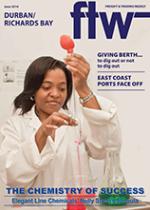Fears over the impact of the
massive refurbishment
project at the Port of
Durban have been allayed
as contingency plans are proving to
be successful.
According to Roy Ramdiyal,
regional manager for Safmarine
in KwaZulu-Natal, Swaziland
and Botswana, there were serious
concerns over the loss of quay
space at container terminals
1 and 2 where deepening and
strengthening had to take place
and what the impact would be on
operations.
“The plans put in place during
the upgrades so far have been
working very well and the effect
of the renovations has not been
as bad as was expected,” he said.
“No doubt the lower container
volumes over the first quarter of
the year played a role in this, but
the introduction of additional
equipment, new straddle carriers
and increased labour resourcing
has assisted in improving
productivity.”
Efficiency at the Port of Durban,
however, remains one of the
greatest challenges.
Due to its configuration and
location, Pier 1 is a particularly
high focus area.
“It is the most susceptible to
wind delays and congestion,” said
Ramdiyal. “Regular meetings are
held with the port management
to understand the constraints and
assist wherever possible to mitigate
delays and
congestion. An
example of this
is the recent
discussions
between the
port, shipping
line and
the Citrus
Growers’
Association
regarding
the improved
productivity
for export reefer containers that
has resulted in the port deploying
reach stackers to handle reefer
containers at Pier 1.”
Ramdiyal said it was essential
that stakeholders in the port
worked together to ensure
productivity remained high as it
was not only the responsibility of
terminal and port operators.
“Shipping lines also play
an important role in keeping
port congestion and delays to a
minimum by ensuring they meet
their berthing windows and
provide the port
with as accurate
as possible time
of arrivals and
operational
information to
assist in planning.”
He said in this
regard Safmarine
had deployed
staff alongside its
vessels, matching
the port shifts, to
assist and monitor
the productivity for improved turntimes
of their vessels.
“Our customers can also assist in
improving the port’s performance
through better utilisation of
the import free time and export
stacking period ie, by also using
the 1st and 2nd free stack days and
accepting or delivering outside the
usual office hours.”
INSERT & CAPTION
Our customers can also
assist in improving the
port’s performance through
better utilisation of the
import free time and
export stacking period.
– Roy Ramdiyal
CAPTION
Improving turnaround time … Safmarine has deployed staff alongside its
vessels, matching the port shifts, to assist and monitor the productivity.

